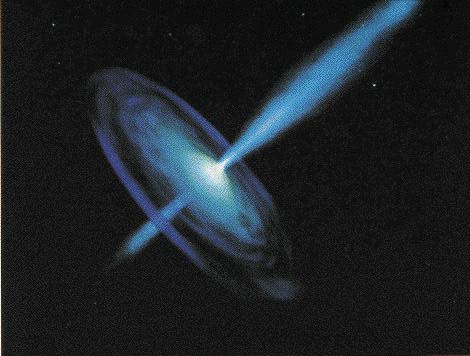| Finally, the cosmic gamma-ray signal is partially masked by a similar
signal from cosmic rays - elementary particles which have a uniform distribution
on the sky and often affect detectors in ways similar to gamma rays. Given
these constraints, the only way to get useful information is to make very
large, complex detectors and fly them above the Earth's atmosphere. As
a result of these difficulties, it has taken several decades for gamma-ray
astronomy to fulfill its promise. Theoretical studies dating back to the
1950's emphasized the value of gamma-ray astronomy. Pioneering instruments,
which paved the way for later satellite-borne experiments, were flown on
rockets and more frequently in high-altitude balloons throughout the 1960's
and 70's, a practice that survives today as a way to test new instrumentation.
These vehicles provide only short observations, insufficient to carefully
observe nature at gamma-ray wavelengths. The first real inroads came with
the pioneering space-borne missions of the 1970's like the SAS 2 and COS-B
missions which provided truly fundamental results in this field. These
instruments explored the nature of diffuse gamma-ray emission, provided
detailed observations of the first known gamma-ray pulsars, and uncovered
a population of unidentified gamma-ray emitters which still puzzle scientists
today. Sometimes early progress came in more unexpected ways. |
As far back as 1968 the Vela satellites - created to monitor the Earth's
atmosphere for nuclear explosions - detected brief bursts of gamma rays
of cosmic origin coming from random directions on the sky. Networks of
subsequent satellites carrying gamma-ray burst detectors established in
the inner solar system since 1976 have produced source locations for these
transients using wavefront arrival timing analysis (a method analogous
to triangulation of ships at sea). However, searches of these source locations
have produced no obvious counterparts to the gamma-ray bursts at any other
wavelength. Whether the source of gamma rays was expected or not, knowing
how gamma rays are produced is the key to understanding what they reveal
about a source. Nature creates gamma rays in a variety of ways. If the
temperature of the environment is high enough - around 100 million degrees
Celsius - they can be produced in a manner similar to less energetic x-ray
radiation. These so-called thermal photons are often produced as a result
of an explosive event such as a supernova. They are also produced through
powerful gravitational interactions such as when a black hole or neutron
star is capturing matter from a companion star. The detection of gamma-ray |
photons produced in this way yields valuable information about how
compact stars interact with their environments and the energy budget of
these sources. One of the original goals of gamma-ray astronomy research
was to study cosmic sources of radiation created by atomic nuclei. These
nuclear lines are the emission of photons at characteristic energies and
are typically produced as a result of normal radioactive decay or through
interactions of particles with nuclei. Just like the more familiar optical
lines caused by the electron transitions in atoms, nuclear lines represent
the much more energetic transitions and interactions of protons and neutrons
inside the atomic nucleus. Gamma rays produced in this manner give scientists
valuable information about how elements are created and destroyed in our
galaxy and beyond. Gamma rays are also produced by other "nonthermal" processes.
This term implies that the photons are the results of fundamental interactions
between elementary particles or between these particles and other photons,
rather than being emitted by a hot, thermal "stew" of plasma. These types
of interactions occur in very special environments, sites like the incredibly
high magnetic fields of young neutron stars or the powerful jets of radiation
emanating from a gigantic black hole. |

